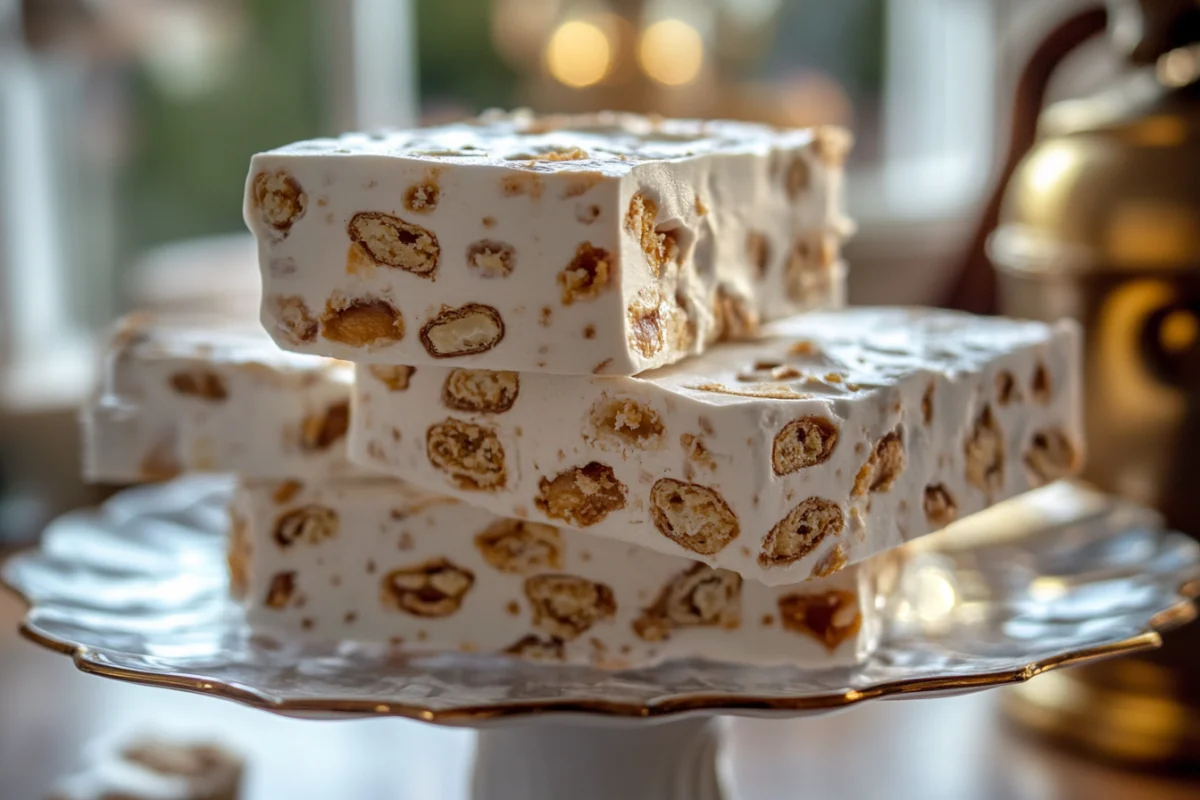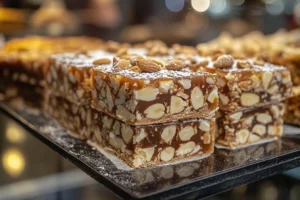Turrón is a traditional Spanish sweet, primarily made from almonds, sugar, honey, and egg whites. It has been enjoyed for centuries, especially during Christmas and other major Spanish festivals. While Turrón is closely associated with Spanish culture, it has also made its way into various regions worldwide, thanks to its unique taste and texture.
To explore Turrón further, check out our Ultimate Guide to Turrón for a deep dive into its history, recipes, and health benefits.
Key Features of Turrón:
- Origin: Spain, particularly from the region of Alicante and Jijona.
- Main Ingredients: Almonds, honey, sugar, and egg whites.
- Varieties: Turrón de Alicante (hard Turrón) and Turrón de Jijona (soft Turrón).
- Cultural Significance: A beloved part of Spanish cuisine, especially during festive seasons like Christmas.
Turrón comes in different textures, but the two most famous varieties are:
- Hard Turrón: Made from roasted almonds and sugar, with a crunchy texture.
- Soft Turrón: Creamy and chewy, made with ground almonds and honey.
This iconic treat is not only enjoyed as a dessert but also serves as a gift and a centerpiece in Spanish homes during special occasions.
What is Nougat?
Nougat, like Turrón, is a confection made from sugar, honey, and nuts. Although it shares some similarities with Turrón, Nougat has its roots in various European cultures, including France, Italy, and Germany. Nougat’s history dates back to ancient times, and its popularity continues to spread globally.
Key Features of Nougat:
- Origin: Ancient origins, dating back to Rome and Medieval Europe.
- Main Ingredients: Sugar, honey, egg whites, and nuts (typically hazelnuts or almonds).
- Varieties: French Nougat, Italian Torrone, and German Nougat.
- Cultural Significance: An important treat in European festive celebrations, such as Christmas and Easter.
Nougat also comes in two primary forms:
- Hard Nougat: Known for its firm and crunchy texture.
- Soft Nougat: Often softer and chewy, with a delicate, sweet flavor.
The primary difference between Nougat and Turrón lies in the regional variations and specific preparation methods, although both feature similar core ingredients. While Turrón tends to use almonds extensively, Nougat often incorporates other nuts, such as hazelnuts and pistachios, depending on the region.
Historical Context and Origin
The Origins of Turrón
Turrón is believed to have originated in Spain, with historical evidence pointing to the region of Alicante, where almond cultivation was prominent. The recipe for Turrón evolved over centuries, influenced by the Mediterranean diet and the Spanish’s rich culinary heritage.
Evolution and Spread of Turrón:
- Ancient Roots: The history of Turrón can be traced back to the Moors in Spain, who introduced almonds and sugar to the region. These ingredients became staples of Spanish cuisine, leading to the creation of Turrón.
- Spanish Influence: Over time, Turrón gained popularity, especially in Valencia and Alicante, and became a common treat during the Christmas season.
- Modern-Day Spain: Today, Turrón is enjoyed throughout Spain and is a quintessential part of the Spanish Christmas tradition.
Turrón has also become a symbol of regional pride, with each region in Spain adding its own unique twist to the recipe. For instance, Jijona, a town near Alicante, is famous for its soft Turrón, while Alicante is known for the hard variety.
The History of Nougat
Nougat has a long and fascinating history, with origins dating back to ancient times in the Mediterranean region. The earliest forms of Nougat were made with honey and nuts, a tradition that likely began in Rome and spread through Greece and the Middle East.
Evolution and Spread of Nougat:
- Ancient Beginnings: Historical records suggest that Nougat was made in Rome as far back as 100 AD, where honey, almonds, and other nuts were combined to create a sweet treat.
- Medieval Europe: By the Middle Ages, Nougat was a popular sweet in both Italy and France, where it evolved into the distinct forms we recognize today French Nougat and Italian Torrone.
- Globalization: In the 20th century, Nougat made its way across the globe and became a key ingredient in many chocolate bars, cakes, and sweets.
In France, for instance, Nougat de Montélimar is an iconic variety, made with hazelnuts and almonds. The Italian version, Torrone, is often flavored with citrus peel and other distinctive ingredients. Over time, these regional variants have influenced the way Nougat is consumed and prepared globally.
Ingredients and Preparation Methods
Ingredients of Turrón
Turrón is made from simple yet high-quality ingredients, which vary depending on the type of Turrón being prepared. The key ingredients include almonds, honey, sugar, and egg whites, though variations of these ingredients exist depending on regional preferences and specific recipes.
Common Ingredients in Turrón:
- Almonds: The primary nut used in Turrón, especially in varieties like Turrón de Alicante and Turrón de Jijona. The quality and origin of almonds significantly impact the flavor.
- Honey: A natural sweetener that provides moisture and a unique flavor to the confection.
- Sugar: Used to give Turrón its sweetness and contribute to its overall texture.
- Egg Whites: Essential in achieving the desired light and airy texture in soft Turrón varieties.
Turrón recipes vary by region, but these ingredients are the building blocks. For example, Turrón de Alicante uses roasted almonds and a higher sugar content for a firmer texture, while Turrón de Jijona has finely ground almonds mixed with honey, making it smoother and softer.
Types of Turrón:
- Turrón de Alicante: A hard variety made with whole almonds and a crunchy texture, traditionally consumed during Christmas.
- Turrón de Jijona: A soft variety with a creamy texture, often used in cakes or as a filling in other desserts.
Ingredients of Nougat
Nougat, though similar to Turrón, can vary significantly depending on the region and its intended use. The base ingredients include sugar, honey, egg whites, and a variety of nuts. In addition to almonds, other nuts such as hazelnuts, pistachios, and cashews are commonly used.
Common Ingredients in Nougat:
- Sugar: The main sweetener, often used in combination with honey.
- Honey: Imparts a subtle floral sweetness and helps to bind the ingredients together.
- Egg Whites: Used to create the airy, chewy texture that is characteristic of soft Nougat.
- Nuts: Typically hazelnuts or almonds, but variations include pistachios, walnuts, and even cashews depending on the region.
Types of Nougat:
- French Nougat: A chewy version made with hazelnuts or almonds, often produced in the town of Montélimar.
- Italian Torrone: A firmer version, often flavored with citrus peel or chocolate.
- German Nougat: Typically made with hazelnuts and known for its creamy, smooth texture.
The Taste and Texture Comparison
Turrón’s Taste and Texture
The texture of Turrón varies depending on the type, but it is always characterized by its distinct combination of almonds and honey. The hard varieties are crunchy, while the soft varieties are chewy and smooth.
Taste and Texture Features of Turrón:
- Hard Turrón: Crunchy with whole almonds and a firm, brittle texture.
- Soft Turrón: Creamy and chewy, with finely ground almonds that blend smoothly with honey.
- Flavor Profile: Sweet with a natural nutty flavor from almonds and a subtle floral sweetness from honey. The sugar content enhances the richness.
Turrón is often enjoyed as a standalone treat, but it can also be used in various desserts or paired with chocolate, cheese, or even fruits like figs.
Nougat’s Taste and Texture
Nougat’s taste and texture are heavily influenced by the nuts used and the preparation method. Whether it’s crunchy or chewy, Nougat offers a delightful combination of sweet, nutty, and sometimes slightly floral flavors.
Taste and Texture Features of Nougat:
- Hard Nougat: Typically firm, with a crunchy texture and whole hazelnuts or almonds embedded within the mixture.
- Soft Nougat: Lighter and fluffier, with a chewy texture that often incorporates pistachios or hazelnuts.
- Flavor Profile: Sweet with a nutty base, often enhanced by vanilla, citrus, or chocolate in certain varieties.
Nougat is enjoyed not only as a sweet treat but also as a filling in chocolate bars, cakes, and other pastries. The texture and flavor can vary from region to region, but all forms share that unique chewy, crunchy combination.
Turrón vs. Nougat: Key Differences
Although Turrón and Nougat share several similarities, they have distinct differences that stem from their ingredients, preparation methods, and cultural backgrounds.
Turrón vs. Nougat: A Side-by-Side Comparison
Key Differences:
- Ingredients: While both sweets use sugar, honey, and egg whites, Turrón primarily features almonds, whereas Nougat can include a broader range of nuts, such as hazelnuts, pistachios, and cashews.
- Texture: Turrón’s texture varies from hard and crunchy to soft and chewy, with a stronger emphasis on almonds. Nougat’s texture, on the other hand, can be either crunchy or chewy, with a lighter feel in softer varieties.
- Flavor: Turrón has a more straightforward nutty flavor, with honey as the dominant sweetener. Nougat tends to have a more complex flavor, often flavored with vanilla, citrus zest, or chocolate.
- Cultural Significance: Turrón is deeply ingrained in Spanish culture, particularly around Christmas, whereas Nougat has widespread popularity across Europe, especially in France, Italy, and Germany.
Turrón: The Spanish Version
Turrón’s distinctiveness lies in its close connection to Spanish culinary traditions. It is not just a sweet; it represents Spain’s agricultural heritage, especially its love for almonds and honey. The preparation of Turrón is steeped in Spanish culture, with certain regions (like Alicante and Jijona) being renowned for their specific varieties.
- Regional Influence: The production of Turrón is highly regionalized in Spain, and the two primary varieties Turrón de Alicante (hard) and Turrón de Jijona (soft) are often made in different regions. Both varieties have a unique texture and flavor due to regional variations in almond types and honey quality.
Nougat: The Global Influence
Unlike Turrón, Nougat has a broader international reach. It is celebrated not just in Europe but also in Middle Eastern countries. The variations in ingredients such as using hazelnuts or pistachios are a testament to Nougat’s adaptation to local tastes and preferences.
- Versatility: Nougat is used in various forms across Europe and beyond, from French Nougat and Italian Torrone to German Nougat and even American candy bars. Its versatility makes it a key ingredient in many festive and everyday confections.
How to Make Turrón and Nougat
How to Make Turrón at Home
Making Turrón at home allows you to experience this delightful treat with a personal touch. The process is relatively simple but requires careful attention to temperature and ingredient ratios.
Basic Ingredients for Homemade Turrón:
- 200g of Almonds (whole for hard Turrón, ground for soft Turrón)
- 150g of Sugar
- 100g of Honey
- 1 Egg White (for soft Turrón)
- A pinch of Salt
Steps to Make Turrón:
- Prepare the Almonds: For Turrón de Alicante, toast the whole almonds until golden. For Turrón de Jijona, grind the almonds into a fine powder.
- Make the Syrup: In a saucepan, combine sugar and honey. Heat gently until it reaches a soft ball stage (around 115°C/240°F).
- Whisk the Egg White: Whisk the egg whites until they form stiff peaks.
- Combine Ingredients: Gradually fold the syrup into the egg whites, then add the almonds. Mix until everything is evenly distributed.
- Shape and Cool: Pour the mixture into a mold, pressing it down firmly. Let it cool completely before slicing.
Homemade Turrón is a delightful experience that captures the essence of Spanish craftsmanship. The fresh ingredients allow for a more natural, less processed taste than store-bought varieties.
How to Make Nougat at Home
Making Nougat at home is similar to Turrón but often involves different nuts and flavorings. The most common varieties are soft and chewy, with hazelnuts, almonds, or pistachios as the main ingredients.
Basic Ingredients for Homemade Nougat:
- 200g of Almonds or Hazelnuts
- 200g of Sugar
- 100g of Honey
- 1 Egg White
- Vanilla or Citrus Zest (optional)
Steps to Make Nougat:
- Prepare the Nuts: Toast the almonds or hazelnuts until lightly golden and set aside to cool.
- Make the Syrup: In a saucepan, combine sugar and honey. Heat until the syrup reaches the soft ball stage (115°C/240°F).
- Whisk the Egg White: Beat the egg whites until stiff peaks form.
- Combine Ingredients: Slowly pour the syrup into the beaten egg whites, stirring gently. Once combined, fold in the nuts and any flavorings (vanilla or citrus).
- Mold and Set: Pour the mixture into a prepared mold, pressing it firmly. Allow it to set for a few hours before slicing into pieces.
Making Nougat at home allows for creative customization, including the use of different nuts, fruits, or even chocolate for a richer taste. The process is also a wonderful way to share a homemade version of this classic treat during holidays or celebrations.
Where to Buy Turrón and Nougat
Where to Buy Turrón
Turrón is widely available in Spain and other parts of Europe, especially during the Christmas season. However, for those who wish to enjoy Turrón year-round or outside of Spain, there are numerous online stores and specialty food shops offering this treat.
Top Places to Buy Turrón:
- Spanish Grocery Stores: Many local Spanish supermarkets or stores that specialize in Mediterranean food will carry a variety of Turrón, especially around the holiday season.
- Online Retailers: Websites like Amazon, La Tienda, or Tienda offer a broad range of Turrón, including the popular varieties like Turrón de Alicante and Turrón de Jijona.
- Specialty Food Markets: High-end grocery stores and markets that specialize in artisan foods may carry gourmet versions of Turrón, made with premium ingredients and intricate recipes.
Look for high-quality Turrón made with fresh almonds and natural honey for the best flavor. Avoid mass-produced varieties with added preservatives, as these may not capture the authentic taste of Turrón.
Where to Buy Nougat
Nougat is available in many specialty stores across Europe and is often found in chocolate shops and candy boutiques. As with Turrón, there are several online retailers offering a wide range of Nougat varieties.
Top Places to Buy Nougat:
- European Candy Shops: Many European confectionery stores, particularly in France and Italy, offer a wide selection of Nougat. Nougat de Montélimar is especially popular in French shops.
- Online Retailers: Websites such as Amazon or specialized nougat shops like Le Nougat de Montélimar offer a range of Nougat from various regions, including hard and soft varieties.
- Gourmet Food Stores: High-end food stores like Whole Foods or Eataly often carry artisanal Nougat, especially around Christmas and Easter.
When purchasing Nougat, opt for handcrafted varieties to ensure a fresh and authentic taste, as mass-produced versions can sometimes lack the richness of flavor.
FAQs
Is Turrón the Same as Nougat?
No, while both are made with similar ingredients like sugar, honey, and egg whites, the primary difference lies in the region of origin and the specific nuts used. Turrón is a traditional Spanish confection, whereas Nougat is a broader European treat with many regional varieties.
What is the Difference Between Hard and Soft Turrón?
Hard Turrón (Turrón de Alicante) has a crunchy texture and uses whole almonds, while soft Turrón (Turrón de Jijona) is creamy and smooth, made with ground almonds.
Can Turrón be Made Without Egg Whites?
Egg whites are typically used in soft Turrón to give it its light and airy texture. However, there are egg-free alternatives available, particularly for people with dietary restrictions.
Is Nougat Gluten-Free?
Many varieties of Nougat are naturally gluten-free, as the main ingredients are honey, nuts, and egg whites. However, it’s always important to check the packaging to ensure no gluten-containing ingredients have been added.
How Long Does Turrón Last?
Turrón has a shelf life of several months if stored in a cool, dry place. Hard Turrón lasts longer than soft Turrón, which should ideally be consumed within a few weeks to retain its chewy texture.
Conclusion
In conclusion, while Turrón and Nougat share similar ingredients and preparation methods, they each have distinct characteristics shaped by their regional origins, textures, and flavors. Turrón, deeply rooted in Spanish tradition, often features almonds and honey, offering both crunchy and chewy varieties. Nougat, with its broader European appeal, uses a wider range of nuts and flavors, making it more versatile.
Whether you’re making them at home or buying from specialty stores, both treats offer a delightful experience. Understanding their unique qualities helps you appreciate their cultural significance and enjoy their distinct tastes.
For inspiration on how to incorporate similar flavors into your recipes, see our Corn Nuggets Recipe Guide for creative ways to experiment with sweet and nutty textures.



